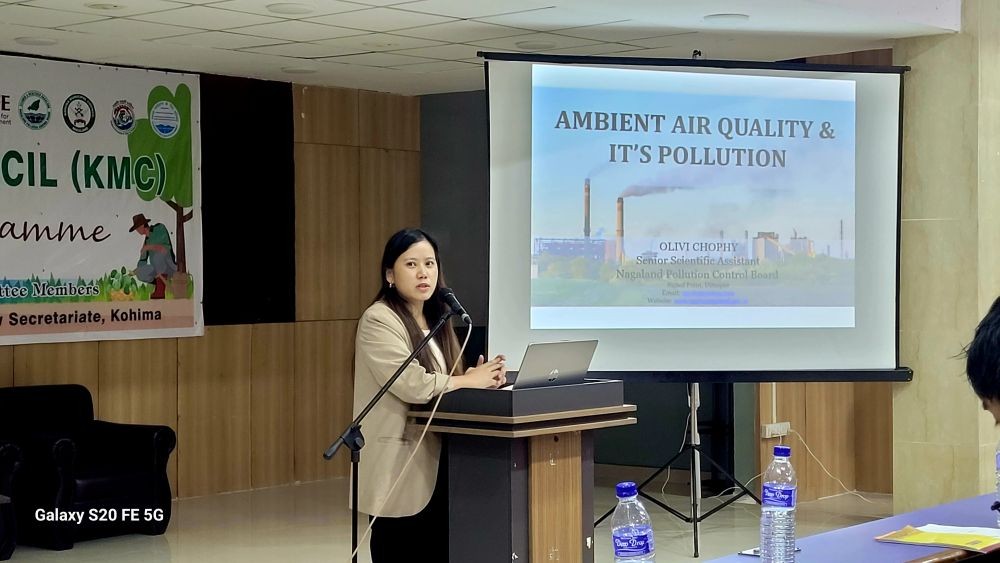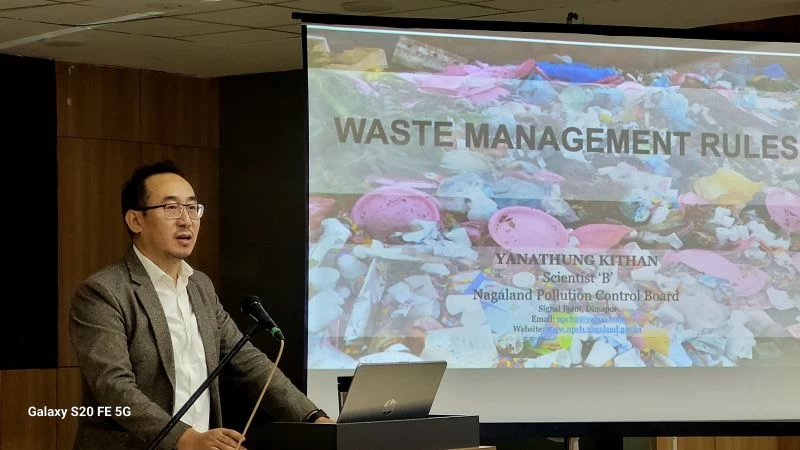Olivi G. Chophy, Senior Scientific Assistant, NPCB speaking at the workshop cum awareness programme at Kohima on May 9. (Morung Photo)

Morung Express News
Kohima | May 9
The air quality of Kohima and Dimapur has been placed under ‘non-attainment city” with respect to Particulate Matter (PM10) raising concerns about the deteriorating air quality in the state.
Olivi G. Chophy, Senior Scientific Assistant, Nagaland Pollution Control Board (NPCB) sharing the findings during a workshop cum awareness programme under Nation Clean Air Programme (NCAP) said the annual average concentration of Respirable Suspended Particulate Matter (RSPM) for Kohima city has crossed the permissible limit for consecutive years from 2020-2023.
To this end, she emphasised that the biggest threat facing the humankind today, is environment pollution, and that the action of the people has direct impact on the environment.

Speaking as one of the resource persons, Chophy informed that eleven manual monitoring stations and 1 CAAQMS station in Nagaland has been installed with seven in Dimapur and four in Kohima.
The central government, she said has launched NCAP as a long-term, time-bound, national level strategy to achieve 40% reduction in particulate matter by 2026.
With Kohima and Dimapur under non-attainment cities, Chophy, underscoring the urgent need for comprehensive measures to improve air quality and protect the health of the people, called for collaborative efforts of all stakeholders to combat environmental pollution in the state.
Yanathing Kithan, Scientist ‘B’ NPCB speaking on waste management informed that three lakh kilos of waste is being generated everyday from the 39 ULBs which are dumped at the dumping sites without any proper treatment.
As for the rural areas comprising of 1355 villages, he said there are no collection systems and no record of waste produced.
Giving a gist of the waste generated during the 10-day Hornbill Festival in 2023, Kithan said a total of 23,000 kgs of waste was generated, 1600 kgs of pet bottles and 360 kgs of aluminium cans including some ‘blood stained syringes.’
He also explained on the importance of waste segregation from the home itself, which he said, can reduce the amount of waste that goes to the dumping sites, and suggested on some simple and easy ways to compost food waste at home.
The Government of Nagaland was also imposed Environment Compensation of Rs 200 crores on ‘Polluter Pays Principle’ for its failure in scientifically managing the liquid and solid waste in violation of the mandate of law particularly judgments of the Supreme Court and the National Green Tribunal Order in November 24, 2022.
Likewise, Kithan informed that about 100 cases pertaining to the state of Nagaland is in its office. Meanwhile, Junior Scientist Assistant, NPCB, Hanpong Konyak spoke on plastic waste management.
The Nagaland Pollution Control Board in collaboration with the Kohima Municipal Council (KMC) has organised the workshop cum awareness programme with ward panchayat chairman, colony chairman, goanburas and sanitation committee members at Capital Convention Centre, Kohima on May 9.




